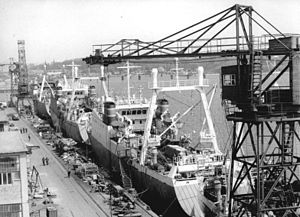Atlantic (ship type)
| Atlantic series | |
|---|---|

|
|
| Technical data (overview) | |
| Shipyard: | Volkswerft , Stralsund |
| Measurement: | 2657 GRT |
| Load capacity: | 1150 t |
| Length over all: | 82.20 m |
| Length between perpendiculars: | 73.00 m |
| Width: | 13.60 m |
| Side height: | 9.55 m |
| Draft: | 5.00 m |
| Drive: | 2 × diesel engine 8 NVD 48.2 AU (SKL Magdeburg) on 1 × controllable pitch propeller |
| Total output: | 2 × 854 kW |
| Speed: | 13.6 knots |
| Crew: | 80 |
The Atlantic- type catch and freeze trawlers were a series of trawlers developed by the Volkswerft in Stralsund with systems for processing the catch.
history
On June 7, 1966, the type ship of the series was completed at the Volkswerft , which, compared to the previously built somewhat smaller Tropik series, had a greater propulsion power and expanded processing options . The first series, called Atlantik I , comprised 50 ships. On December 23, 1968, the Soyus-3 was delivered, the first further developed type Atlantik II , which was manufactured in Stralsund until 1973. A total of 161 units had been completed here by the end of 1973, mostly to the Soviet Union , including seven combined fishing and research vessels and seven fishing training vessels, but also to Bulgaria (12 vessels passed on from the USSR), Romania (8 vessels) and Cuba (5th Ships) were exported. From 1974 a further 24 ships were completed at the Mathias-Thesen-Werft in Wismar , while the Volkswerft produced the successor model, the Atlantic Supertrawler . The total production of the types Atlantik I & II comprised 185 units. The ships from Wismar were also exported to the USSR, Romania and Cuba .
technology
The trawlers were designed for use in flotilla fishing in connection with mother ships and equipped for the special conditions of tropical waters. The planned deployment time was 60 days. One of the special features was the remote control of all fishing winches from the bridge . The interchangeable net technology made it possible to fish alternately with two trawls . After the catch had been brought in on the 36 meter long catch deck, it was brought into four pre-cooled collecting bunkers. Two belt freezers with a capacity of 45 tons per day were used to freeze the fish, which was then stored in the 1040 cubic meter hold at −25 ° C. 165 cubic meters of cargo space were available for the up to 35 tons of fish meal that could be produced per day.
The further development to Type II included changes to the bridge house and the superstructures, the elimination of the bulkhead between holds I & II and a large freezer, as well as changes to the fish processing plant. From the 82nd ship, the Akmolinsk , handed over on February 20, 1970 , the ships were equipped for interchangeable nets.
Two diesel engines from SKL Magdeburg , each with an output of 854 kilowatts, worked via a gearbox on a controllable pitch propeller . The trawlers thus reached a cruising speed of 13.6 knots. A towing speed of 6 knots was achieved with a pull of 167 kilonewtons .
literature
- Alfred Dudszus, Alfred Köpcke: The big book of ship types. Steam ships, motor ships, marine technology from the beginnings of machine-driven ships to the present day. transpress Pietsch, Berlin Stuttgart 1990, ISBN 3-344-00374-7 , p. 42.
- Neumann, Manfred; Strobel, Dietrich: From the cutter to the container ship . Ships from GDR shipyards in text and images. 1st edition. VEB Verlag Technik, Berlin 1981.

